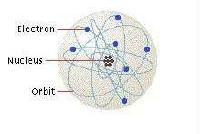Radioactivity: Discovering the Nucleus, the Proton and the Neutron
About the same time as Thomson's experiments with cathode rays, physicists such as by Henri Becquerel, Marie Curie, Pierre Curie, and Ernest Rutherford were studying radioactivity. Radioactivity was characterized by three types of emitted rays (see How Radioactivity Works for details):
- Alpha particles - positively charged and massive. Ernest Rutherford showed that these particles were the nucleus of a helium atom.
- Beta particles - negatively charged and light (later shown to be electrons).
- Gamma rays - neutrally charged and no mass (i.e., energy).
The experiment from radioactivity that contributed most to our knowledge of the structure of the atom was done by Rutherford and his colleagues. Rutherford bombarded a thin foil of gold with a beam of alpha particles and looked at the beams on a fluorescent screen, he noticed the following:
Advertisement
- Most of the particles went straight through the foil and struck the screen.
- Some (0.1 percent) were deflected or scattered in front (at various angles) of the foil, while others were scattered behind the foil.
Rutherford concluded that the gold atoms were mostly empty space, which allowed most of the alpha particles through. However, some small region of the atom must have been dense enough to deflect or scatter the alpha particle. He called this dense region the nucleus (see The Rutherford Experiment for an excellent Java simulation of this important experiment!); the nucleus comprised most of the mass of the atom. Later, when Rutherford bombarded nitrogen with alpha particles, a positively charged particle that was lighter than the alpha particle was emitted. He called these particles protons and realized that they were a fundamental particle in the nucleus. Protons have a mass of 1.673 x 10-24 grams, about 1,835 times larger than an electron!
However, protons could not be the only particle in the nucleus because the number of protons in any given element (determined by the electrical charge) was less than the weight of the nucleus. Therefore, a third, neutrally charged particle must exist! It was James Chadwick, a British physicist and co-worker of Rutherford, who discovered the third subatomic particle, the neutron. Chadwick bombarded beryllium foil with alpha particles and noticed a neutral radiation coming out. This neutral radiation could in turn knock protons out of the nuclei of other substances. Chadwick concluded that this radiation was a stream of neutrally charged particles with about the same mass as a proton; the neutron has a mass of 1.675 x 10-24 grams.
Now that the parts of the atom were known, how were they arranged to make an atom? Rutherford's gold foil experiment indicated that the nucleus was in the center of the atom and that the atom was mostly empty space. So, he envisioned the atom as the positively charged nucleus in the center with the negatively charged electrons circling around it much like a planet with moons. Although he had no evidence that the electrons circled the nucleus, his model seemed reasonable; however, it presented a problem. As the electrons moved in a circle, they would lose energy and give off light. The loss of energy would slow the electrons down. Like any satellite, the slowing electrons would fall into the nucleus. In fact, it was calculated that a Rutherford atom would last only billionths of a second before collapsing! Something was missing!
